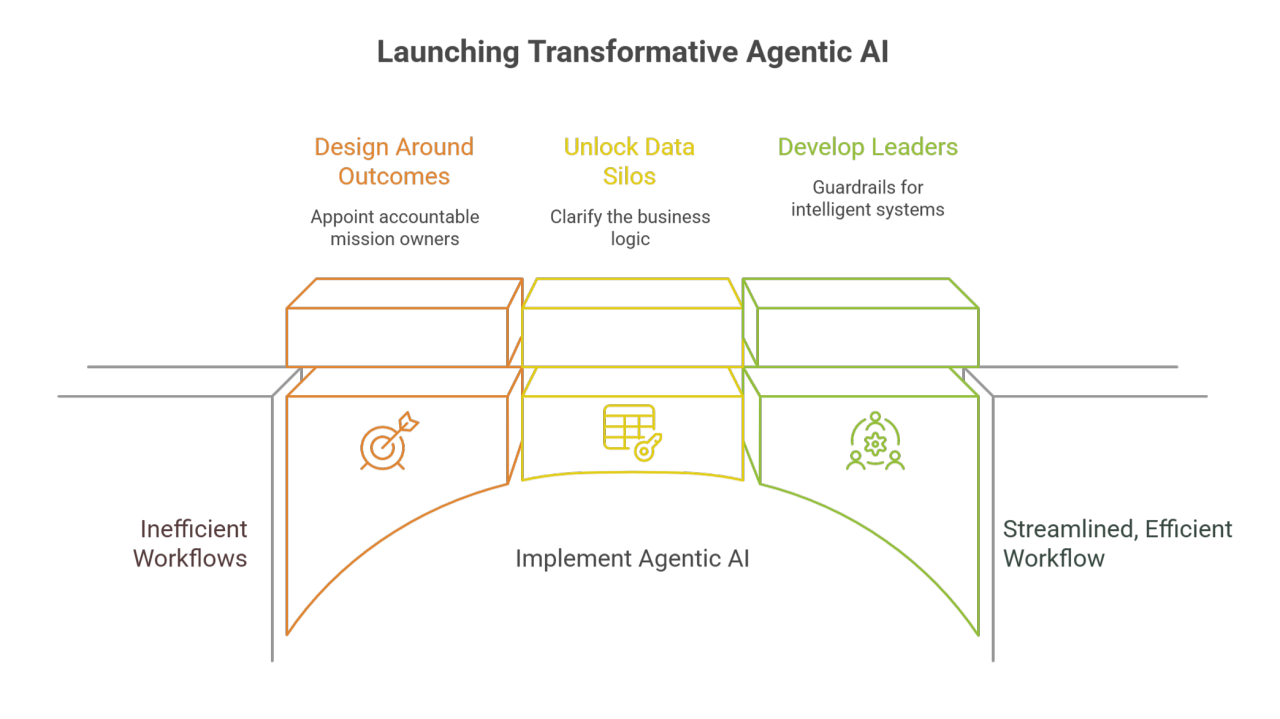Agentic AI: The Three Imperatives for Success
Agentic AI systems represent a significant evolution in intelligent automation, moving beyond simple robotic process automation (RPA) or rules-based tasks to deliver tangible business outcomes. For companies looking to realize the promise of this technology, it is not enough to simply use bolt-on tools or make minor process tweaks. Unlocking the value of agentic AI demands that companies redesign how they think about their workforce and, critically, how their organizations are structured.
Agentic AI systems are capable of executing workflows, making decisions, and coordinating activities across departments. Think of agentic AI as a team of digital colleagues. These agents can range from specialists, like a coding copilot, to generalists who stitch together the work of many experts to achieve a larger outcome. When orchestrated as a cohesive system, agentic AI acts as an intelligent layer that links scattered processes and cuts through silos into a more seamless flow.
Based on successful implementations, here are three essential imperatives for designing a successful agentic AI system:
1. Design Around Outcomes and Appoint Accountable Mission Owners
Many enterprises are structured around internal functional silos (e.g., Marketing answers to Brand, Billing answers to Finance), which fails to serve the customer journey. Customers, however, experience the organization seamlessly and expect companies to continuously innovate and resolve issues at the root.
To succeed with agentic AI, organizations must rethink their structure and design around outcomes, not just tasks. This requires a new kind of thinking.
For every major journey, companies must appoint a mission owner. This owner defines the mission, steers both the human and AI agents, and owns the overall outcome. This role requires cross-functional authority and visibility.
For example, in a hiring workflow, the mission owner is accountable for the full journey—including sourcing, IT setup, training, and early performance reviews—until a new hire is fully contributing, measuring success by key performance indicators (KPIs) like “time to first commit”.
2. Unlock Data Silos and Clarify the Business Logic
A common misconception is that AI requires pristine, centralized data. In reality, AI agents can operate across existing, often siloed systems, negating the need for organizations to undergo the difficult work of consolidating multiple systems into a single reference data set.
Agentic AI offers hope for organizations trapped in stifling legacy structures and organizational silos. AI agents are equipped to manage data silos when they are given a clearly defined shared business logic and access to contextual data via Application Programming Interfaces (APIs) and metadata.
To implement agentic AI, businesses need to codify how work is performed—including decisions made and what “good” looks like for customers and employees throughout core journeys.
Organizations utilizing multi-agent applications must still invest in making data interoperable at the semantic (meaning and context) and operational levels. Mapping workflows for agentic AI deployment often reveals weaknesses in existing data and knowledge management, such as outdated or missing data, or valuable meta-level information residing only in the minds of specific individuals. Creating an up-to-date knowledge foundation not only improves agentic AI performance but also strengthens information reliability across the entire organization.
3. Develop the Leaders and Guardrails that Intelligent Systems Require
These necessary structural shifts will not succeed without leaders who can effectively manage and steward the agentic AI transformation.
First, organizations must build agentic AI literacy at every level. Employees need to understand how these systems work, why they reach certain conclusions, and when human supervision is required. Leaders must also proactively address employee fears and misconceptions.
Second, governance must be built into the design of these systems, with the right sets of guardrails. This includes:
- Creating clear process flows for automation and analytics.
- Defining approval criteria and embedding policy constraints into agent behavior.
- Establishing clear escalation paths for when problems exceed the scope of the agent.
- Performing real-time monitoring with auditable logic to track agent performance.
Finally, for these structural shifts to succeed, leaders must be comfortable delegating to systems they cannot fully script. Leaders need to prioritize the desired outcome and ensure that the workflow handles exceptions effectively. Stewardship of agentic AI requires a distribution of responsibility, empowering frontline teams to intervene when outcomes diverge, while system stewards maintain controls, and IT professionals manage security and data handling.
Ready to build transformative agentic AI for your business?
Book a call with CloudBloq
https://calendar.app.google/4A5MqjjLmQxnxs9r7
Watch a brief summary here,
Reference – https://hbr.org/2025/10/designing-a-successful-agentic-ai-system





